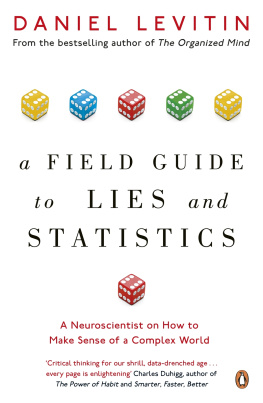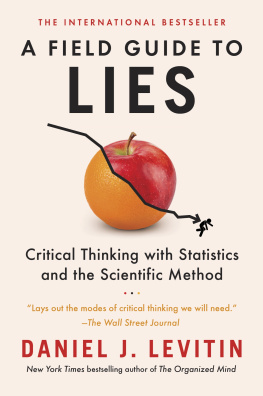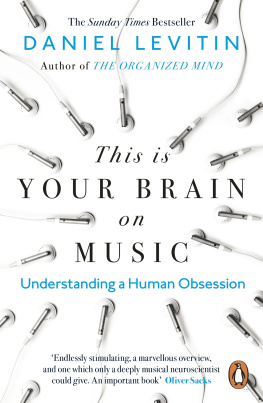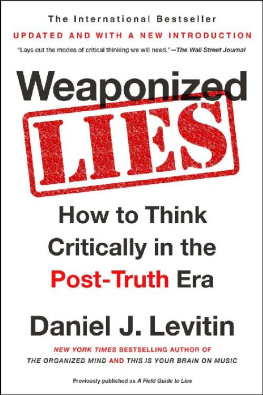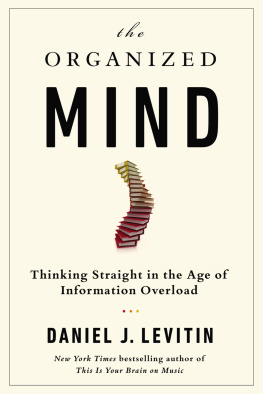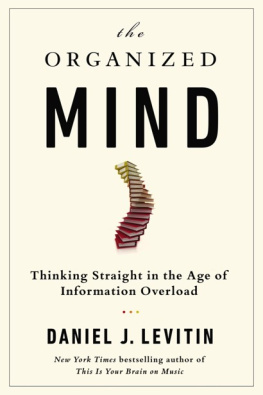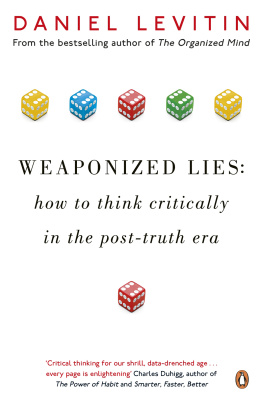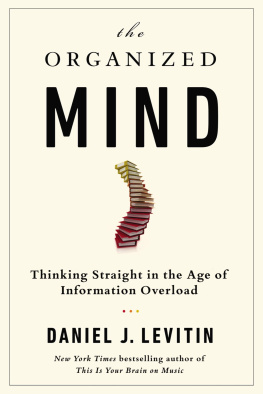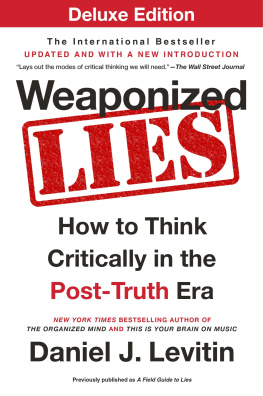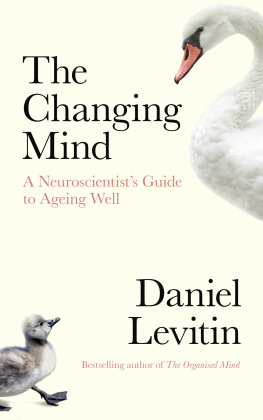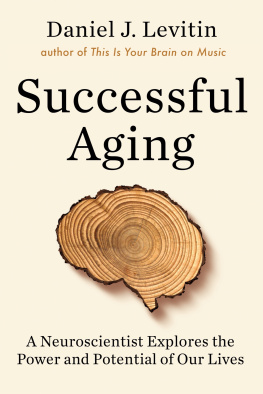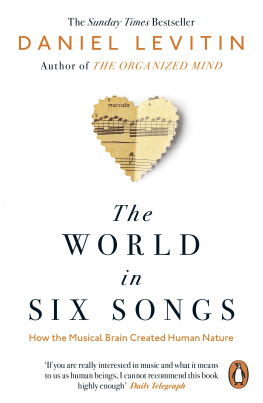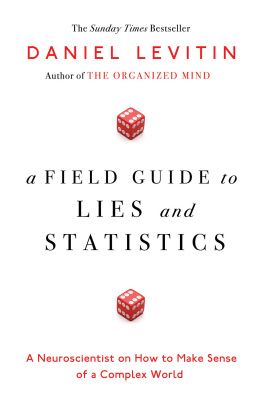Contents
Daniel Levitin
A FIELD GUIDE TO LIES AND STATISTICS
A Neuroscientist on How to Make Sense of a Complex World
VIKING
UK | USA | Canada | Ireland | Australia
India | New Zealand | South Africa
Viking is part of the Penguin Random House group of companies whose addresses can be found at global.penguinrandomhouse.com.
First published in the United States of America by Dutton as A Field Guide to Lies 2016
First published in Great Britain by Viking 2016
Copyright Daniel J. Levitin, 2016
The moral right of the author has been asserted
Cover design by Mecob
Photograph: Shutterstock.com / Mega Pixel
All art courtesy of the author unless otherwise noted.
Images 2016 by Dan Piraro, used by permission.
Image 2016 by Alex Tabarrok, used by permission.
Image .
Image 2016 by Tyler Vigen, used by permission.
Image .
Image is public domain and provided courtesy of Harrison Propser.
ISBN: 978-0-241-97486-5
ABOUT THE AUTHOR
Dr Daniel J. Levitin has a PhD in Psychology, and trained at Stanford University Medical School and the University of California Berkeley. He is the author of the number-one bestseller This Is Your Brain On Music (Dutton, 2006), published in nineteen languages, and the bestsellers The World in Six Songs (Dutton, 2008) and The Organized Mind (Viking, 2014). Currently he is Dean of Social Sciences at the Minerva Schools at KGI in San Francisco, and a faculty member at the Center for Executive Education in the Haas School of Business at UC Berkeley.
THE BEGINNING
Let the conversation begin
Follow the Penguin Twitter.com@penguinUKbooks
Keep up-to-date with all our stories YouTube.com/penguinbooks
Pin Penguin Books to your Pinterest
Like Penguin Books on Facebook.com/penguinbooks
Listen to Penguin at SoundCloud.com/penguin-books
Find out more about the author and
discover more stories like this at Penguin.co.uk
To Shari,
whose inquisitive mind made me a better thinker
Introduction
Thinking, Critically
This is a book about how to spot problems with the facts you encounter, problems that may lead you to draw the wrong conclusions. Sometimes the people giving you the facts are hoping youll draw the wrong conclusion; sometimes they dont know the difference themselves. Today, information is available nearly instantaneously, but it is becoming increasingly hard to tell whats true and whats not, to sift through the various claims we hear and to recognize when they contain misinformation, pseudo-facts, distortions, and outright lies.
There are many ways that we can be led astray by fast-talking, loose-writing purveyors of information. Here, Ive grouped them into two categories, and they make the first two parts of this book: numerical and verbal. The first category includes mishandled statistics and graphs; the second includes faulty arguments, and the steps we can take to better evaluate news, statements, and reports. The last part of the book addresses what underlies our ability to determine if something is true or false: the scientific method. It grapples with the limits of what we can and cannot know, including what we know right now and dont know just yet, and includes some applications of logical thinking.
It is easy to lie with statistics and graphs because few people take the time to look under the hood and see how they work. I aim to fix that. Recognizing faulty arguments can help you to evaluate whether a chain of reasoning leads to a valid conclusion or not. Related to this is infoliteracyrecognizing that there are hierarchies in source quality, that pseudo-facts can easily masquerade as facts, and biases can distort the information we are being asked to consider, leading us to faulty conclusions.
You might object and say, But its not my job to evaluate statistics critically. Newspapers, bloggers, the government, Wikipedia, etc., should be doing that for us. Yes, they should, but they dont always. Weeach of usneed to think critically and carefully about the numbers and words we encounter if we want to be successful at work, at play, and in making the most of our lives. This means checking the numbers, the reasoning, and the sources for plausibility and rigor. It means examining them as best as we can before we repeat them or use them to form an opinion. We want to avoid the extremes of gullibly accepting every claim we encounter or cynically rejecting every one. Critical thinking doesnt mean we disparage everything, it means that we try to distinguish between claims with evidence and those without.
Sometimes the evidence consists of numbers and we have to ask, Where did those numbers come from? How were they collected? Sometimes the numbers are ridiculous, but it takes some reflection to see it. Sometimes claims seem reasonable, but come from a source that lacks credibility, like a person who reports having witnessed a crime but wasnt actually there. This book can help you to . And catch some lying weasels in their tracks.
Weve created more human-made information in the last five for thousands of years, and was documented in biblical times and classical Greece. The unique problem we face today is that misinformation has proliferated; it is devilishly entwined on the Internet with real information, making the two difficult to separate. And misinformation is promiscuousit consorts with people of all social and educational classes, and turns up in places you dont expect it to. It propagates as one person passes it on to another and another, as Twitter, Facebook, Snapchat, and other social media grab hold of it and spread it around the world; the misinformation can take hold and become well known, and suddenly a whole lot of people are believing things that arent so.
Part One
EVALUATING NUMBERS
It aint what you dont know that gets you into trouble.
Its what you know for sure that just aint so.
MARK TWAIN
Plausibility
Statistics, , how to go about counting, which of the resulting numbers they will share with us, and which words they will use to describe and interpret those numbers. Statistics are not facts. They are interpretations. And your interpretation may be just as good as, or better than, that of the person reporting them to you.
Sometimes, the numbers are simply wrong, and its often easiest to start out by conducting some quick plausibility checks. After that, even if the numbers pass plausibility, three kinds of errors can lead you to believe things that arent so: how the numbers were collected, how they were interpreted, and how they were presented graphically.

